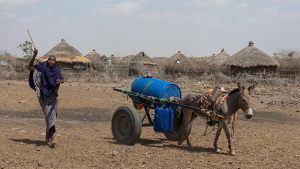The 1998 Border Conflict behind Ethiopia's Civil War

A decades-old rivalry between Eritrea and the TPLF risks derailing Ethiopia’s peace deal.
Ethiopia’s brutal civil war has paused following a peace deal between the Ethiopian government and the Tigrayan People’s Liberation Front (TPLF) signed late last year. Humanitarian aid is finally making its way to some of the 5.4 million people in Tigray in dire need of assistance after bearing the brunt of the conflict. Phones are ringing for the first time in two years as telecommunications are restored to the region, and reports of troop disarmament and withdrawals have sparked hope that this agreement will hold.
Yet peace remains fragile. One of the biggest threats is neighboring Eritrea. Eritrean President Isaias Afwerki’s regime was neither party to nor explicitly mentioned in the peace agreement, but the country has played a devastating role in the conflict as the Ethiopian government’s partner in war. Whether Eritrean troops will fully withdraw from the Tigray region—a necessary step for sustainable peace—remains unclear.
Eritrea's Role and History
Eritrea’s presence in the war has internationalized an otherwise internal conflict and contributed to widespread acts of sexual violence and ethnic cleansing against Tigrayans. While peace negotiations were underway late last year, Eritrean forces were reportedly killing civilians, looting homes, and burning crops. Underlying this violence is a long, bitter feud that dates back to a 1998 border war between the Isaias regime and the TPLF.
Isaias rose to power as the leader of the Eritrean People’s Liberation Front (EPLF), an armed group that fought for independence from the Derg, the military junta that ruled Ethiopia and present-day Eritrea. Before the TPLF and EPLF were staunch enemies, they shared similar Marxist-Leninist ideologies, social composition, and ethnolinguistic background. They even fought in unison against the Derg, ultimately prevailing in 1991 and becoming the ruling parties, with the TPLF leading Ethiopia and the EPLF leading an independent Eritrea.
Years later, Eritrea introduced its own currency under the expectation that it would be used in trade with Ethiopia. However, Ethiopia insisted on trading in dollars. Tensions between the two neighbors grew over disputed borders and trade, and relations eventually fell apart when clashes over Badme, a small border village, led to all-out war. Countless civilians were displaced, and as many as 100,000 people lost their lives in Africa's deadliest border war to date.
In 2000, the international community brokered a peace deal between the two countries and established an independent boundary commission that awarded Badme to Eritrea. The TPLF-led Ethiopian regime stalled on implementing the decision, opting instead to contain Eritrea and isolate it internationally. When Ethiopia subsequently emerged as a dominant player in the region, the United States and other key international players turned a blind eye to the TPLF’s violation.
Isaias and Abiy: A Common Foe
Cut off from the world, Eritrea slid into repressive, totalitarian politics, earning the title of “Africa’s North Korea.” Isaias cracked down on dissidents, independent press, and religious freedoms and introduced mandatory youth conscription, all the while blaming the TPLF for the nation’s issues. This deep-seated resentment toward Ethiopia grew into a decades-long stalemate between the two states until Prime Minister Abiy Ahmed was elected as Ethiopia’s first non-TPLF leader in 2018.
Abiy, who campaigned on reformation and reconciliation, forged a peace deal with Eritrea which earned him the 2019 Nobel Peace Prize. But hope didn’t last long. Over the following 11 months, Isaias and Abiy met frequently, sometimes in secret. Some former Ethiopian officials have suggested that the Nobel provided an opportunity for the two leaders to quietly plan for war against the TPLF. When war broke out in Tigray in November 2020, the Eritrean army fought alongside Ethiopian forces in a scorched-earth offensive that has left an estimated 600,000 people dead.
Given the history between the EPLF and TPLF, Isaias sees Tigray as a threat to his regional influence and his ability to project power into Ethiopia. Many experts argue that he seeks revenge against the TPLF for the 1998 border war and his subsequent isolation.
To fully implement the peace deal, Ethiopia must follow up on its pledge to secure its northern border against foreign incursions, which requires the full withdrawal of Eritrean troops. TPLF disarmament could encourage Isaias to cooperate, but it might not be enough.


Related Content
 Global Politics
Global Politics
"The US and others must take a more direct approach before the worst fears of the Tigrayan people are realized," Elizabeth Shackelford writes.
 Global Politics
Global Politics
Ethiopia's brewing civil conflict could have a broader impact on the region's politics and US policies towards the continent.
 US Foreign Policy
US Foreign Policy
War in Tigray is escalating fast. “We have effective nonmilitary leverage and options in our toolbox and should use them,” writes Elizabeth Shackelford in the Chicago Tribune.
